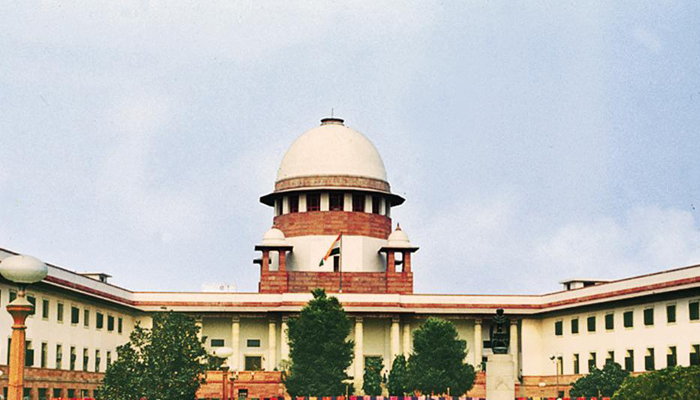TRENDING TAGS :
Ayodhya Dispute: SC fixes February 8 as next date of hearing
New Delhi: The Supreme Court will commence on February 8, 2018 its hearing on a batch of petitions challenging a 2010 Allahabad High Court verdict on the Ayodhya title suit that had divided the disputed Babri Masjid site between the Nirmohi Akhara, Lord Ram deity and the Sunni Waqf board.
A bench of Chief Justice Dipak Misra, Justice Ashok Bhushan and Justice S. Abdul Nazeer directed that all the advocates on record will work in harmony and ensure that all documents are filed, if not already filed.
During the hearing, the petitioners pleaded for reasonable time to translate, file and serve the copies of all the exhibits and relevant documents, which were filed before the Allahabad High Court bench at Lucknow in Uttar Pradesh.
Meanwhile, Shia Waqf Board Chairman Wasim Rizvi, who had proposed to construct Ram Mandir in Ayodhya and a separate Babri Masjid in Lucknow, said, "Good news is that the Supreme Court has taken the formula proposed by us on record."
Advocates Kapil Sibal, Rajiv Dhawan along with other petitioner counsels have, however, sought to constitute a larger bench of at least seven Judges to hear the sensitive matter.
The especially constituted bench of the apex court was hearing a total of 13 appeals filed against the 2010 judgment of the Allahabad High Court in four civil suits.
Earlier, on August 11, the SC had granted three-month time for making translation of the historic documents as Sunni Waqf board, during the hearing, stated that the translation of historic documents is not complete yet.
Also Read: SC to commence hearing on Ayodhya dispute from today
Supreme Court had said that all those parties, in the case, who are now dead can be replaced by legal heir/substitute for the proceedings.
In next slide: Brief timeline of before and after the demolition of Babri Masjid
1853: First incident of communal violence between Hindus and Muslims was recorded.
1859: A fence was built on the orders of British colonial administration, separating the places of worship for Muslims and Hindus.
1949: Hindus had allegedly placed idol of Lord Ram inside the Mosque, triggering massive protest by Muslims. A civil suit was filed from both the sides. The government proclaims the premises a disputed area and locks the gates.
1984: Vishwa Hindu Parishad party (VHP) was formed to free the birth place of Lord Ram. VHP also planned to build a temple in his honour. The campaign was helmed by BJP veteran Lal Krishna Advani.
1986: District judge passed an order to unlock the gates of Babri Mosque to allow Hindus to worship. A Babri Mosque Action Committee was formed by Muslims to protest the court’s order.
1989: VHP laid the foundation stone of a Ram temple on land adjacent to the disputed mosque.
1990: VHP volunteers partially damaged the mosque. Prime Minister Chandra Shekhar tried to resolve the dispute through negotiations but his efforts went in vain.
1991: Change of government and BJP came to power in Uttar Pradesh.
1992: VHP supporters (Shiv Sena and BJP) demolished the Mosque. A nationwide protest was observed that left behind over 2000 people dead.
1998: A coalition government was formed by BJP under Prime Minister Atal Behari Vajpayee.
2001: VHP pledged again to build Hindu temple at the site on the Babri demolition anniversary.
Jan 2002: PM Atal Behari Vajpayee constituted an Ayodhya cell in his office and appointed a senior official, Shatrughna Singh to hold talks with Hindu and Muslim leaders.
Feb 2002: VHP kept a deadline of March 15 to begin construction of Ram Temple. Hundreds of volunteers were gathered on the construction site. A train carrying Hindu activists from Ayodhya was attacked in Godhra in Gujarat, killing at least 58 people.
Mar 2002: Gujarat observed communal riots after the train attack, killing between 1,000 to 2,000 people, mostly Muslims.
Apr 2002: Three High Court judges begin hearings on determining who owns the religious site.
Jan 2003: Archaeologists begin a court-ordered survey to find out whether a temple to Lord Ram existed on the site.
Aug 2003: Survey said that a temple do exists beneath the Mosque but Muslims refuted it. Vajpayee was committed to build Ram Mandir at the disputed land and openly announced it at the funeral of Hindu activist Ramchandra Das Paramhans.
Sept 2003: A court rules that seven Hindu leaders should stand trial for inciting the destruction of the Babri Mosque, but no charges are brought against Advani, who was also at the site in 1992.
Oct 2004: Advani says his party still has “unwavering” commitment to building a temple at Ayodhya.
Nov 2004: A court in UP ruled to review an earlier order which exonerated Advani for his role in the demolition of the mosque.
July 2005: Suspected Islamic militants attacked the disputed site, using a vehicle with explosives. Security forces gunned down five people they say are militants, and a sixth who was not immediately identified.
June 2009: The Liberhan commission investigating events leading up to the mosque’s demolition submits its report – 17 years after it began its inquiry.
Nov 2009: There was uproar in parliament as the commission blamed leading politicians from the Hindu nationalist BJP for a role in the destruction of mosque.
Sept 2010: Allahabad High Court rules that the site should be split, with the Muslim community getting control of a third, Hindus another third and the Nirmohi Akhara sect the remainder. Control of the main disputed section, where the mosque was torn down, is given to Hindus. A lawyer for the Muslim community said he will appeal.
May 2011: Supreme Court suspends High Court ruling after Hindu and Muslim groups appeal against the 2010 verdict. The two judge bench of Supreme Court remarked that the HC verdict was surprising as no party wanted a split of the site.



